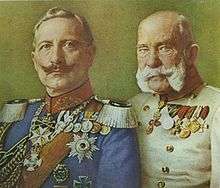Kaiser-Walzer
|
A section from Kaiser-Walzer (3:01)
|
| Problems playing this file? See media help. |
Kaiser-Walzer, Op. 437 (Emperor Waltz) is a waltz composed by Johann Strauss II in 1889. The waltz was originally titled Hand in Hand and was intended as a toast made in August of that year by Austrian emperor Franz Joseph I on the occasion of his visit to the German Kaiser Wilhelm II where it was symbolic as a 'toast of friendship' extended by Austria to Germany.
Strauss' publisher, Fritz Simrock, suggested the title Kaiser-Walzer since the title could allude to either monarch, and thus satisfy the vanity of both rulers. The waltz was first performed in Berlin on 21 October 1889. The original cover of the piano edition bore the illustration of the Austrian Imperial Crown.
composition

A quiet march starts the waltz's introduction before a sweeping crescendo heralds the gentle principal melody of the first waltz. As more waltz sections are introduced, the mood remains constantly upbeat and triumphant. A cello solo near the end of the work reprises the melody of the first waltz section, before a trumpet fanfare ushers the end of the work, complete with a drumroll on the timpani and a strong brass flourish.
- Waltz 2

References
Based on original text by Peter Kemp, The Johann Strauss Society of Great Britain. Used with permission.
|
|---|
|
| Operettas | |
|---|
|
| Waltzes |
- Sinngedichte, Op. 1 (1844)
- Gunstwerber, Op. 4 (1844)
- Sträußchen, Op. 15 (1846)
- Klange aus der Walachei, Op. 50 (1850)
- Frohsinns-Spenden, Op. 73 (1850)
- Lava-Ströme, Op. 74 (1850)
- Rhadamantus-Klänge, Op. 94 (1851)
- Idyllen, Op. 95 (1851)
- Mephistos Höllenrufe, Op. 101 (1851)
- Liebeslieder, Op. 114 (1852)
- Phönix-Schwingen, Op. 125 (1853)
- Novellen, Op. 146 (1854)
- Nachtfalter, Op. 157 (1855)
- Glossen, Op. 163 (1855)
- Man lebt nur einmal!, Op. 167 (1855)
- Abschieds-Rufe, Op. 179 (1856)
- Phänomene, Op. 193 (1857)
- Abschied von St. Petersburg, Op. 210 (1858)
- Hell und voll, Op. 216 (1859)
- Promotionen, Op. 221 (1859)
- Accelerationen, Op. 234 (1860)
- Immer heiterer, Op. 235 (1860)
- Grillenbanner, Op. 247 (1861)
- Klangfiguren, Op. 251, (1861)
- Dividenden, Op. 252
- Karnevalsbotschafter, Op. 270 (1862)
- Leitartikel, Op. 273 (1863)
- Morgenblätter, Op. 279 (1863)
- Studentenlust, Op. 285 (1864)
- Aus den Bergen, Op. 292 (1864)
- Bürgersinn, Op. 295 (1865)
- Flugschriften, Op. 300 (1865)
- Wiener Bonbons, Op. 307 (1866)
- An der schönen blauen Donau, Op. 314 (1867)
- Künstlerleben, Op. 316 (1867)
- Die Publicisten, Op. 321 (1868)
- G'schichten aus dem Wienerwald, Op. 325 (1868)
- Illustrationen, Op. 331 (1869)
- Wein, Weib und Gesang, Op. 333 (1869)
- Freuet Euch des Lebens, Op. 340 (1870)
- Neu Wien, Op. 342 (1870)
- Tausend und eine Nacht, Op. 346 (1871)
- Wiener Blut (waltz), Op. 354 (1873)
- Carnevalsbilder, Op. 357 (1873)
- Bei uns Z'haus, Op. 361 (1873)
- Wo die Zitronen blühen, Op. 364 (1874)
- Du und du, Op. 367 (1874)
- Cagliostro-Walzer, Op. 370 (1875)
- O schöner Mai!, Op. 375 (1877)
- Rosen aus dem Süden, Op. 388 (1880)
- Nordseebilder, Op. 390 (1880)
- Kuss-Walzer, Op. 400 (1881)
- Frühlingsstimmen, Op. 410 (1883)
- Lagunen-Walzer, Op. 411 (1883)
- Schatz-Walzer, Op. 418 (1885)
- Wiener Frauen, Op. 423 (1886)
- Donauweibchen, Op. 427 (1887)
- Kaiser-Jubiläum-Jubelwalzer, Op. 434 (1888)
- Kaiser-Walzer, Op. 437 (1888)
- Rathausball-Tänze, Op. 438 (1890)
- Gross-Wien, Op. 440 (1891)
- Seid umschlungen, Millionen!, Op. 443 (1892)
- Trau, schau, wem!, Op. 463 (1895)
- Farewell to America
|
|---|
|
| Polkas |
- Herzenslust, Op. 3
- Explosions-Polka, Op. 43
- Veilchen, Op. 132
- Tritsch-Tratsch-Polka, Op. 214 (1858)
- Demolirer, Op. 269 (1862)
- Vergnügungszug, Op. 281 (1864)
- 'S gibt nur a Kaiserstadt, 's gibt nur a Wien!, Op. 291
- Lob der Frauen, Op. 315
- Postillon D'Amour, Op. 317 (1867)
- Leichtes Blut, Op. 319 (1867)
- Figaro-Polka, Op. 320 (1867)
- Ein Herz, ein Sinn!, Op. 323
- Freikugeln, Op. 326 (1868)
- Éljen a Magyar!, Op. 332
- Im Krapfenwald'l, Op. 336 (1869)
- Die Bajadere, Op. 351
- Vom Donaustrande, Op. 358
- Bitte schön!, Op. 372 (1875)
- Auf der Jagd, Op. 373 (1875)
- Banditen-Galopp, Op. 378 (1877)
- Waldine, Op. 385 (1879)
- Neue Pizzicato Polka, Op. 449
|
|---|
|
| Marches | |
|---|
|
| Quadrille | |
|---|
|
| Other | |
|---|
|
| Family | |
|---|
|
| In media | |
|---|

